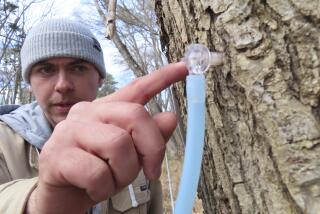Mountain Nectar : Maple Trees in the Alleghenies Surrender Their Pungent Syrup
- Share via
PICKENS, W.Va. — In torrential rain, I head deep into the Allegheny Mountains of West Virginia, leaving pasture and farmsteads for state forest as the road snakes up into the clouds. As I cross a pass, the temperature drops abruptly. Blacktop ends, and I roar along the dirt track, engine in second gear.
My arrival at Mike Richter’s maple house seems like a return to civilization. “Come in; come in,” he urges as the pungent sweetness of maple vapor hits my nose. A long, open tank of maple syrup is simmering gently, clouds of steam rising from the surface. The tank is divided into channels, and Richter explains that as the syrup concentrates, it gradually moves by gravity along the tank, sinking to the far end, where it is drawn off for filtering.
Fifty gallons of sap are needed to make a single gallon of syrup, and in the old days, extraction was done with heat. Now, however, the formidable task of evaporation is speeded by a high-pressure machine that extracts water from the pure sap by reverse osmosis (the same principle used for water desalination), concentrating it to a proportion of 20 to 1.
Then traditional simmering extracts the final maple syrup, which is tested for concentration with a hydrometer. But Richter scarcely needs it. Like a jam-maker, he tests to see if the syrup sheets from a spoon and knows almost by instinct when it is ready.
Richter leads me to the window, where a dozen little bottles are filled with gleaming syrup ranging in color from clear honey yellow to caramel gold to mahogany.
“Concentration of them all is the same,” Richter says. “The clear, light golden syrup is the start of the run. It gradually darkens, acquiring more sediment, until the last syrup of the run is almost brown. It tastes different, too.”
He hands me a spoon and I eagerly dip in. The golden syrup has a refreshing bite, which mellows in the darker syrups to a full-bodied, almost wine-like flavor, my favorite. Richter is a purist and prefers the first-run syrup, which is best for making pale candies and maple cream. Dark syrup has more impact for cooking.
The rain lets up, and we venture outside to inspect the trees growing wild on the mountainside. Some are festooned with the traditional lidded tin buckets, others are draped with transparent PVC pipes that lead down to the maple house, where the sap is collecting in 1,500-gallon drums.
“I’ve about 4,000 taps out right now in about 2,000 trees. Big trees can take two or three taps, the young ones only one,” says Richter.
A maple tree can be tapped when it’s about 30 years old and will continue to live and produce for 200 years or more if not over-tapped.
Maple syrup is like wine; there’s a subtle difference between syrups from Vermont and West Virginia, and they also vary from year to year. When a summer is sunny, the trees store generous amounts of sugar in their roots, which circulates the next spring when the sap runs. Flow varies from day to day. “Sometimes it’s a steady trickle; then other days it’s a slow plunk, plunk,” Richter says.
Sap runs only when nights are freezing. If a warm spell comes along for a week or more, the taps will dry out and the season will be finished because retapping harms the trees. In a good year, the run will last six weeks, into mid-March, ending only when the tree buds pop and the sap turns bitter.
MAPLE-WALNUT MUFFINS
2 1/2 cups flour
1 teaspoon baking soda
1/2 teaspoon salt
1 1/2 cups walnut pieces
2 eggs
1 cup sour cream
1 1/2 cups maple syrup
Butter
Sift about 3/4 cup flour with baking soda and salt into bowl.
Combine walnuts with remaining flour in food processor and finely chop. (Note: Do not over-process or nuts will be oily.) Stir nuts into flour mixture. Make well in center of flour mixture in bowl.
Whisk eggs in bowl just until mixed. Whisk in sour cream and 1 cup maple syrup until thoroughly combined. Pour into well in flour mixture and stir until batter is mixed but still slightly rough. (Note: If over-mixed, muffins will be heavy.)
Spoon batter into buttered muffin cups. Bake at 425 degrees until muffins are peaked, start to pull away from sides of cups and toothpick inserted in center comes out clean, 18 to 22 minutes.
Let muffins cool 2 to 3 minutes in pan. Remove from pan and, while still warm, dip peaks into remaining 1/2 cup maple syrup. Set on rack to cool.
12 muffins. Each muffin:
336 calories; 125 mg sodium; 44 mg cholesterol; 14 grams fat; 48 grams carbohydrates; 6 grams protein; 0.76 gram fiber.
More to Read
Eat your way across L.A.
Get our weekly Tasting Notes newsletter for reviews, news and more.
You may occasionally receive promotional content from the Los Angeles Times.










